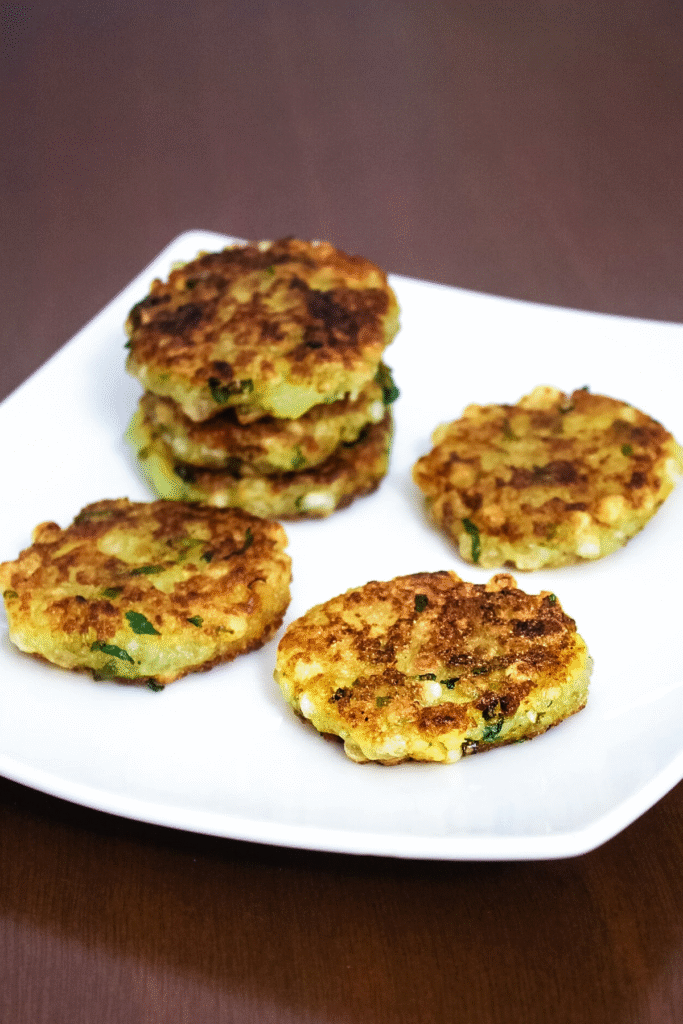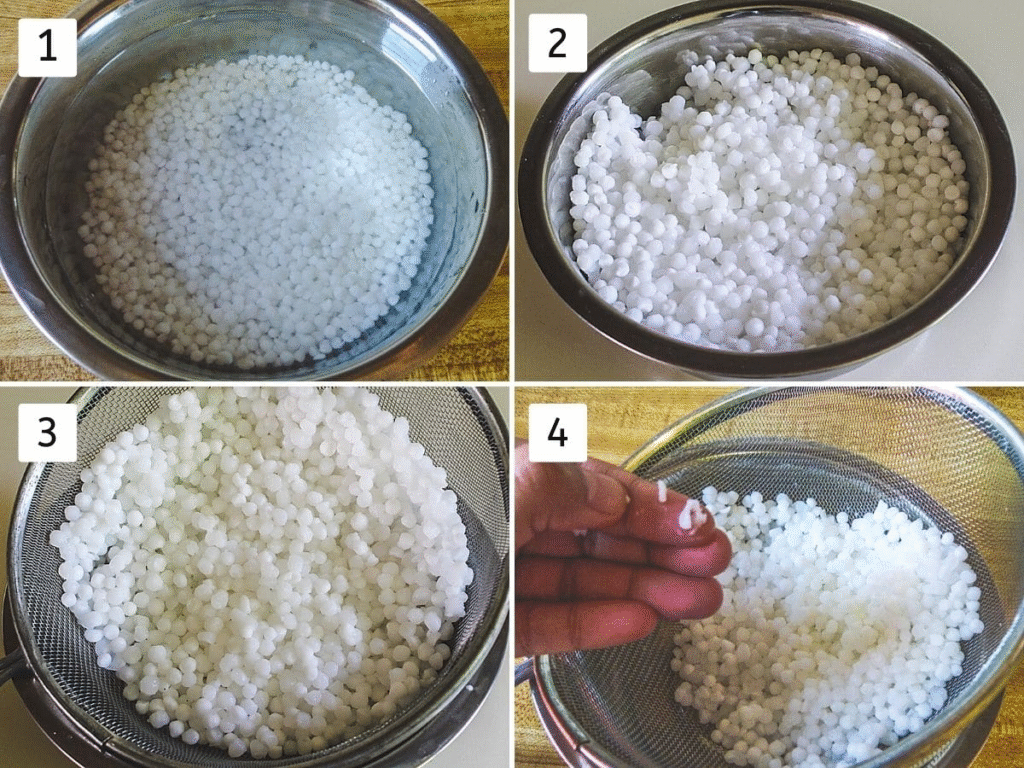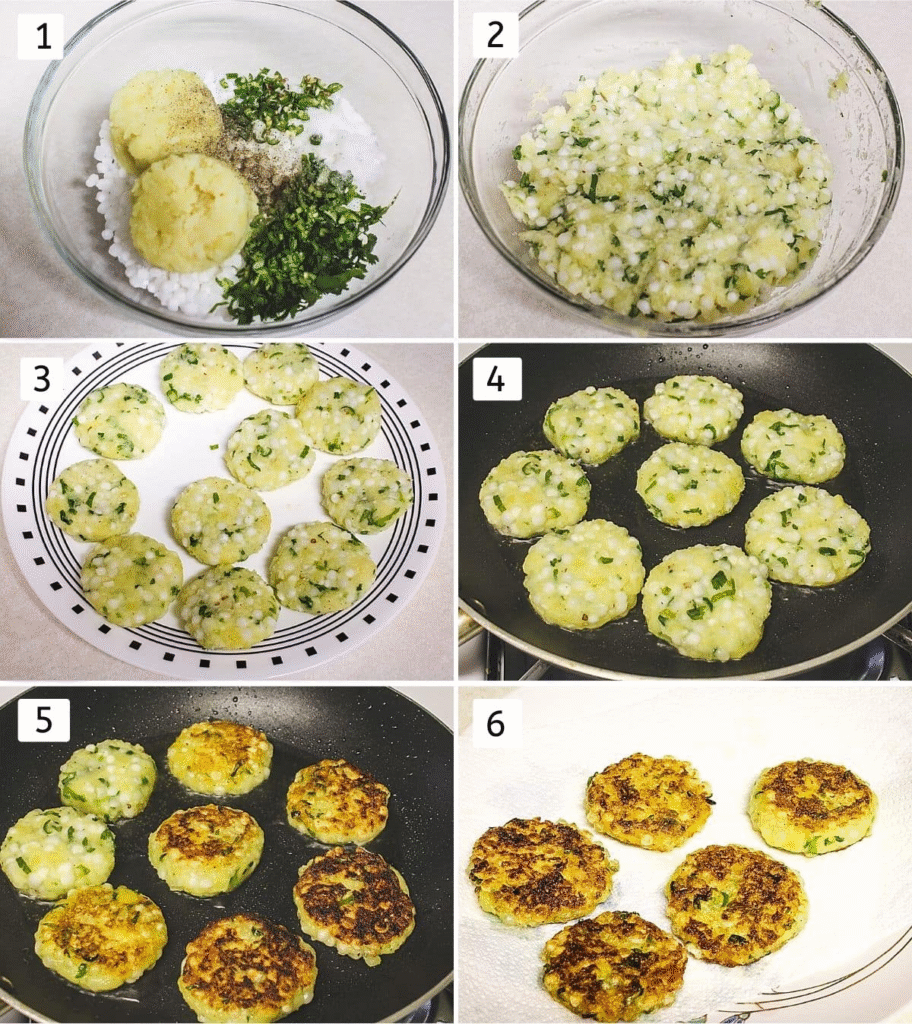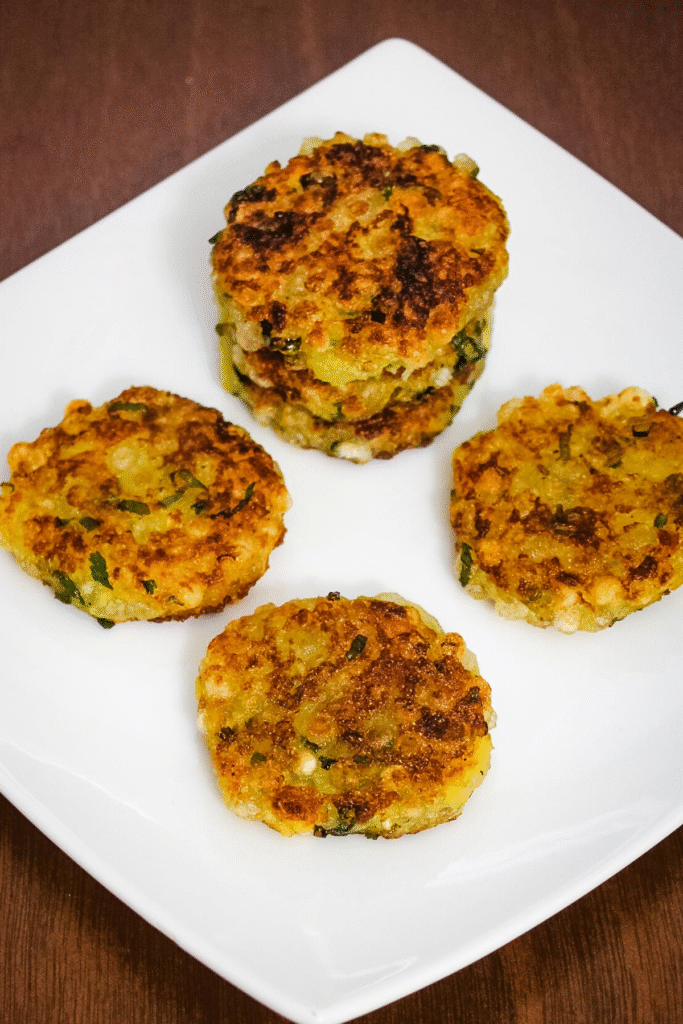Sabudana tikki is a popular Indian fasting (vrat) snack that’s easy to prepare and absolutely delicious. These crispy golden patties are made using soaked sabudana (tapioca pearls), mashed boiled potatoes, roasted peanuts, and a few vrat-approved spices. The outer crust turns beautifully crisp when pan-fried, while the inside remains soft, tender, and melt-in-the-mouth – just the way a good tikki should be!
What makes sabudana tikki truly special is its texture contrast and mild nutty flavor from the peanuts. Whether you’re observing Navratri, Ekadashi, or any other Hindu fasting day, these tikkis are a go-to option. They are naturally gluten-free and can be made vegan with just a few mindful choices.
Pair it with a vibrant farali green chutney made from coriander, mint, green chilies, lemon juice, and sendha namak (rock salt) – and you’ve got yourself a tempting, satisfying snack. They also taste amazing with plain yogurt or sweetened curd for a richer experience.
What makes these tikkis truly special is their simplicity—they come together effortlessly with just a few basic pantry ingredients. Plus, they’re freezer-friendly! Shape them in advance, stash them in the freezer, and then cook straight from frozen whenever hunger strikes for a fuss-free snack.

❤️ You’ll Love This Sabudana Tikki Recipe
- You only need 8 basic ingredients (plus a bit of oil for shallow frying) to bring this wholesome recipe to life, making it wonderfully simple and pantry-friendly.
- Delicately spiced yet bursting with flavor, these tikkis strike a beautiful balance – they don’t rely on heavy spices but still deliver a satisfying and delicious taste in every bite.
- Unlike the traditionally deep-fried sabudana vada, these are shallow-fried in minimal oil, resulting in a crisp outer layer without being overly greasy – perfect for those who prefer a lighter, healthier option.
- Sabudana tikki is a classic during Hindu fasting periods, such as Navratri, Ekadashi, Maha Shivratri, Gauri Vrat, and other vrat days. Its ingredients are vrat-approved, making it a go-to snack for spiritual observances.
- Thanks to its starchy base and nutritious ingredients, this tikki is not just a light bite – it’s hearty enough to serve as a complete breakfast or satisfying snack during fasts when meal choices are limited.
- Though designed with vrat in mind, its appeal goes beyond fasting rituals. With its comforting texture and subtle flavors, you can enjoy sabudana tikki any day of the year—be it a weekend brunch, an evening snack, or part of a festive meal.
🧾 Ingredient Notes
Here’s a quick glance at the ingredients you’ll need to whip up irresistibly crispy sabudana tikkis. The list is short and fuss-free, but don’t let that fool you—the flavor payoff is absolutely worth it!

- Sabudana (Tapioca Pearls): Sabudana, also known as tapioca pearls, is the star ingredient in this recipe. These small, white pearls are derived from the starch extracted from cassava roots and are a rich source of carbohydrates. During Hindu fasting (vrat) days, sabudana is commonly consumed as it provides quick energy and keeps you feeling full for an extended period. Once soaked, the pearls turn soft and slightly chewy, making them ideal for shaping into tikkis or cutlets. They also help absorb the flavors of the spices and other ingredients beautifully.
- Potatoes: Boiled and mashed potatoes work as the base and binding agent in this tikki mixture. Their natural starch helps hold the sabudana together, ensuring the tikkis don’t fall apart while frying. For best results, use red potatoes or Yukon gold potatoes—these varieties have a waxy texture and balanced moisture, making them perfect for Indian cooking as they don’t get overly mushy or watery when boiled. Avoid overly starchy potatoes like russets, which may lead to a soggy mixture.
- Green Chilies: These add the perfect kick of heat to the otherwise mild tikkis. Finely chopped green chilies not only elevate the flavor but also bring a refreshing, earthy pungency. You can adjust the quantity depending on your spice tolerance—add more if you enjoy a fiery edge, or reduce for a milder bite suitable for kids or sensitive stomachs.
- Sugar and Lime Juice: This duo brings balance to the flavor profile. A small amount of sugar adds a subtle sweetness that complements the starchy base and contrasts beautifully with the spiciness from green chilies. A generous squeeze of fresh lime juice introduces a light tang, which brightens the entire mixture and adds a zesty freshness. Together, sugar and lime uplift the dish, making each bite multidimensional and satisfying.
👩🍳 How To Make Sabudana Tikki Recipe? (Pics)
Soaking Sabudana:
1) Take sabudana in a colander and wash beneath running cold water till water runs clear. Make beyond any doubt to get freed of all the starch something else, the vada blend will gotten to be sticky.
– At that point drench in the water for 3-4 hours or overnight (depending on the sort of your sabudana). The one we get here in the USA continuously requires overnight soaking.
2) After the splashing time, they swell up nearly all the water and they gotten to be twofold in size.
3) Exchange them into the colander, rest for 15-20 minutes and let the abundance water deplete out. You must get freed of most of the dampness something else, the vada blend will ended up free and sticky.
4) when you press between your fingers it ought to squash effectively. That’s how you know that your sabudana is drenched perfectly.

Making Sabudana Tikki:
1) Combine Ingredients: In a large mixing bowl, add all the prepared ingredients—this includes soaked and drained sabudana (tapioca pearls), mashed boiled potatoes, crushed peanuts, finely chopped green chilies, fresh coriander, cumin seeds, salt (as per vrat requirements), and lemon juice if using. Do not add oil at this stage.
2) Blend everything exceptionally well. You ought to be able to frame tikki. If the blend looks free, you can include 1-2 tablespoons of rajgira atta or singhare ka atta.
3) Oil your hand with oil and begin forming the tikkis. Orchestrate them in a single layer on the plate. After shaping 4-5 tikkis, the blend may begin to adhere to your hand. So wash your hands, once more oil it and shape it.
4) Presently warm the oil in a pan on medium warm. Once hot put the tikkis.
5) Flip them once the foot side is a pleasant brilliant brown and crispy.
6) Once cooked another side as well, evacuate them on the paper-towel-lined plate. Serve the sabudana tikki hot or warm. As it cools, it begins to gotten to be delicate and will lose its crispness.

💭 Expert Tips For Sabudana Tikki
- Thorough Washing is Crucial: Sabudana (tapioca pearls) is full of surface starch, which can make your mixture overly sticky if not removed properly. Instead of simply rinsing under water, place the sabudana in a colander and wash them under cold running water. Use your fingers to gently rub the pearls as you wash them.This step removes the surplus starch, paving the way for light, separate grains that won’t turn sticky during cooking. Avoid the quick rinse method—it won’t remove enough starch.
- Proper Soaking is the Key: One of the most common reasons for hard or chewy tikkis is inadequately soaked sabudana.Once soaked, the pearls should turn soft and easily squash between your thumb and forefinger with gentle pressure. If they resist mashing, that means they’re still under-soaked. When under-soaked sabudana is cooked, it remains hard and chewy, and you’ll feel that unpleasant crunch and stickiness on your teeth while eating.
- Ideal Soaking Water Ratio: Use a precise soaking method to get the best texture.A handy trick is to use equal parts sabudana and water—like 1 cup of sabudana with 1 .1 cup of water—for perfectly soaked, non-sticky pearls.A handy trick is to use equal parts sabudana and water—like 1 cup of sabudana with A simple yet effective method is to soak sabudana in a 1:1 ratio with water—say, 1 cup of sabudana with 1 cup of water—to achieve soft, well-separated pearls without any stickiness. Stir once and cover. Let them soak for 4–6 hours or preferably overnight, depending on the variety.
- Drain Excess Water Thoroughly: Even after soaking, moisture is your enemy when it comes to shaping tikkis. Once soaked, transfer the sabudana to a colander and allow them to drain completely—at least 15–20 minutes. You can even leave them spread out on a muslin cloth or paper towel to absorb any last traces of moisture. Any residual water will make the mixture soggy and hard to bind, leading to broken or mushy tikkis during frying.
- Fixing a Sticky Mixture: If you accidentally added more water than needed or didn’t drain properly and the mixture turns soft or sticky, don’t panic. Just mix in 1–2 tablespoons of vrat-friendly flour such as rajgira (amaranth), singhara (water chestnut), or kuttu (buckwheat) flour. These help absorb the extra moisture and also aid in binding. If you’re not fasting, feel free to use rice flour instead—it works wonderfully to dry out and firm up the mixture.

